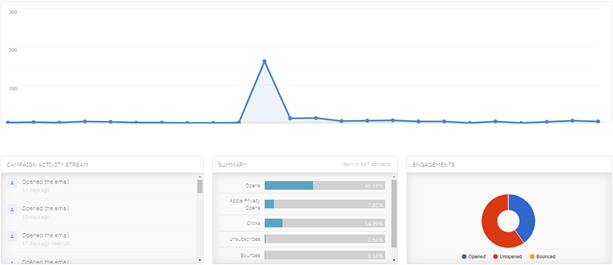
Welcome Email Tips: Why They Work and How to Make Them Better
Welcome emails help businesses engage customers, generate revenue, and build loyalty. Learn how to make the right first impression with your emails. …
Email is alive! And so are these metrics.
Email metrics are more than just numbers and percentages – they’re the heartbeat of your campaign. When understood both individually and collectively, these metrics tell a comprehensive story. In this post, we’ll dive into five key metrics that we measure here at Aztek and explore why each is crucial and how they interconnect. We’ll also look at ways to optimize each of the metrics we cover.
It’s one thing to know which metrics to analyze, and it’s another to truly understand the story they tell about your email marketing success. These five key email marketing metrics each have something important to say, so let’s break down what they are, how to calculate them, and why it’s worth your time to know them.

What It Is
The open rate is the percentage of email recipients who open your email. Open rates are more than just a measure of who opens your emails, it’s a first impression metric and contributes to gauging the effectiveness of your email marketing efforts. Open rates have been under scrutiny since September 2021 because of Apple Mail Privacy Protection (MPP), but is still an important metric when used alongside other numbers, like click-through-rate.
How It’s Calculated
Open rate = (Total number of emails opened / Total delivered) x 100%
Why It’s Valuable
In the beginning, open rates were used to help gauge the initial level of interest or engagement your audience has with your brand. Businesses can still gauge engagement with open rates when combined with other metrics, but Apple MPP has made this particular calculation less reliable.
Open rates are inflated because Apple pre-loads images in emails, which can trigger open tracking pixels even if the user hasn't opened the email. This issue made it difficult to use the open rate alone to gauge campaign effectiveness. You can establish a new “norm” or average open rate taking Apple MPP into consideration, as well as other metrics, and be able to make conclusions on effectiveness when things fluctuate. For example, a sudden drop in open rates, especially when paired with a decline in click rates, could indicate issues ranging from ineffective subject lines to deliverability problems.
How to Optimize

What It Is
Click-Through-Rate is a metric that measures the percentage of email recipients who clicked on one or more links in your email. It’s a behavioral indicator that tells you what portion of your audience found your content compelling enough to take action. Unlike CTOR (covered later), CTR considers the entire email list, not just those who opened the email.
How It’s Calculated
CTR = (Unique clicks / Number of delivered emails) x 100%
Why It’s Valuable
The CTR directly correlates with engagement and conversions. Having a high CTR means your email content is effective at getting the user to take the desired action, whether you want them to “read more” on a featured article or download a new eBook. Used in conjunction with other metrics like open rate and conversion rate, CTR provides a more holistic view of campaign performance.
How to Optimize

What It Is
CTOR is an engagement metric that measures the effectiveness of your email content by showing how many of the people who opened your email also interacted with it. It’s the percentage of subscribers who clicked on the email as related to the total number who opened it. Unlike CTR, CTOR focuses solely on the behavior of those who opened the email.
How It’s Calculated
CTOR = (Unique clicks / Unique opens) x 100%
Why It’s Valuable
CTOR is valuable because it measures the effectiveness of your email content and call-to-actions by comparing clicks to opens. It helps in assessing the quality and relevance of your email content. When used alongside other metrics like open rate and CTR, it provides a more nuanced understanding of your email campaign's performance, ultimately helping in optimizing ROI.
How to Optimize

What It Is
The unsubscribe rate is a feedback mechanism that indicates a disconnect between what you promised your email recipients and what you delivered. It's a percentage of subscribers who chose to opt-out of receiving emails from you.
How It’s Calculated
Unsubscribe Rate = (Number of unsubscribes / Total emails delivered) x 100%
Why It’s Valuable
The unsubscribe rate is valuable because it serves as a direct indicator of your subscribers' satisfaction with what you send and when you send it, as well as the relevance of your email content. A high unsubscribe rate could signal that your emails are no longer meeting your audiences' expectations and/or that your content is no longer relevant. It can also affect sender reputation. A low or decreasing unsubscribe rate can validate that your email marketing strategy is effective! When used alongside open rate, CTR, and CTOR, it can provide a comprehensive view of email engagement.
How to Optimize

What It Is
The deliverability rate refers to the percentage of emails that reach the recipient's inbox instead of getting filtered out as spam or bouncing back. In simple terms, it's like confirming that your letter was actually delivered to the mailbox, setting the stage for all subsequent interactions.
How It’s Calculated
Deliverability Rate = (Number of emails delivered / Number of emails sent) x 100
Why It’s Valuable
Deliverability rate serves as a foundation for all other email marketing metrics. If your emails aren’t reaching your subscribers inbox, other metrics like open rate, CTR, and CTOR become irrelevant. A high deliverability rate means that your emails are reaching inboxes and have the opportunity for users to see and engage with them. It also helps in identifying issues with spam filters and poor list quality. By monitoring this metric, you’re able to keep a pulse on your overall email marketing health.
How to Optimize

Email marketing metrics are like colors of the rainbow – they’re all helpful, but you’ll only find the pot of gold at the end of your journey if they all work together. Understanding each of these metrics in isolation can provide valuable insights, but it's crucial to recognize how they are interconnected for a comprehensive view of your email campaign's performance. Each metric is a piece of a larger puzzle that, when put together, gives you a holistic understanding of your email marketing effectiveness.
A couple of “simple” examples:
So you know a lot more about key email marketing metrics – now what? If you’re ready to expand your email marketing efforts, you can start to tell your own success story through your data. Of course, that’s if you have the time and knowledge it takes to create welcome emails, drip campaigns, and all sorts of other email marketing tactics.
The good news is that you don’t have to tackle these projects on your own. Aztek partners with businesses to bolster their digital marketing efforts, including crafting quality emails and tackling all those technical details needed to drive the positive engagement and conversions your heart desires. Contact us today to about email marketing services or any other digital marketing needs.